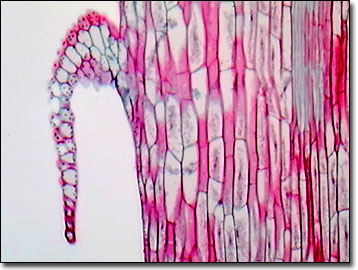Brightfield Digital Image Gallery
Moss Capsule
Like other members of the nonvascular plant phylum Bryophyta, mosses require water (even in the form of heavy dew) to assist in reproduction. They are simple, rootless green plants that flourish in moist and shaded terrestrial habitats. Mosses were the first plants to grow on the Earth's mineral substrate, and can be found worldwide clinging to soil, rocks, and trees, in locations as biologically and climatically diverse as the rainforests of the Amazon and coastal Antarctica.

View a low magnification image of the moss capsule.
As with many other types of primitive plant, the bryophytes reproduce through alternating sexual and asexual generations. Water facilitates transport of sperm from the male antheridium to the female archegonium, where the sperm fertilizes an egg to produce a zygote. From zygotes, elongated structures (setae) begin to grow out of the clumps of moss. Upon reaching maximum length, the tips of the setae begin to enlarge to form capsules, or sporangia. The sporangium, a spore-bearing structure, contains minute, developing spores and is attached to the seta by a structure called a foot. Inside the capsule, spores divide by meiosis, mature, and are shed by wind currents and breezes. Close examination of the capsule reveals a protective cover called the operculum, which falls away from the parasitic sporophyte upon maturity. In order to ensure their release into a moisture-laden environment, mature spores must pass by humidity-sensitive peristomal structures known as the teeth. The teeth increase and decrease the size of the opening at the end of the capsule by swelling and contracting in accordance with the moisture content in the air.
Mosses provide benefit to their ecosystems by breaking down exposed soil, thereby freeing nutrients for uptake by the roots of complex plants. Additionally, these low-lying evergreen plants reduce the damaging effects of water and wind erosion on soil structure by providing vegetative cover and absorption of water in moist terrestrial environments. Many animals depend on mosses as a source of nutrition, or in the case of some small invertebrates, as cover habitat providing a moist microclimate.
Contributing Authors
Cynthia D. Kelly, Thomas J. Fellers and Michael W. Davidson - National High Magnetic Field Laboratory, 1800 East Paul Dirac Dr., The Florida State University, Tallahassee, Florida, 32310.
BACK TO THE BRIGHTFIELD IMAGE GALLERY
BACK TO THE DIGITAL IMAGE GALLERIES
Questions or comments? Send us an email.
© 1995-2025 by Michael W. Davidson and The Florida State University. All Rights Reserved. No images, graphics, software, scripts, or applets may be reproduced or used in any manner without permission from the copyright holders. Use of this website means you agree to all of the Legal Terms and Conditions set forth by the owners.
This website is maintained by our
Graphics & Web Programming Team
in collaboration with Optical Microscopy at the
National High Magnetic Field Laboratory.
Last Modification Friday, Nov 13, 2015 at 01:19 PM
Access Count Since September 17, 2002: 9990
Visit the website of our partner in introductory microscopy education:
|
|
